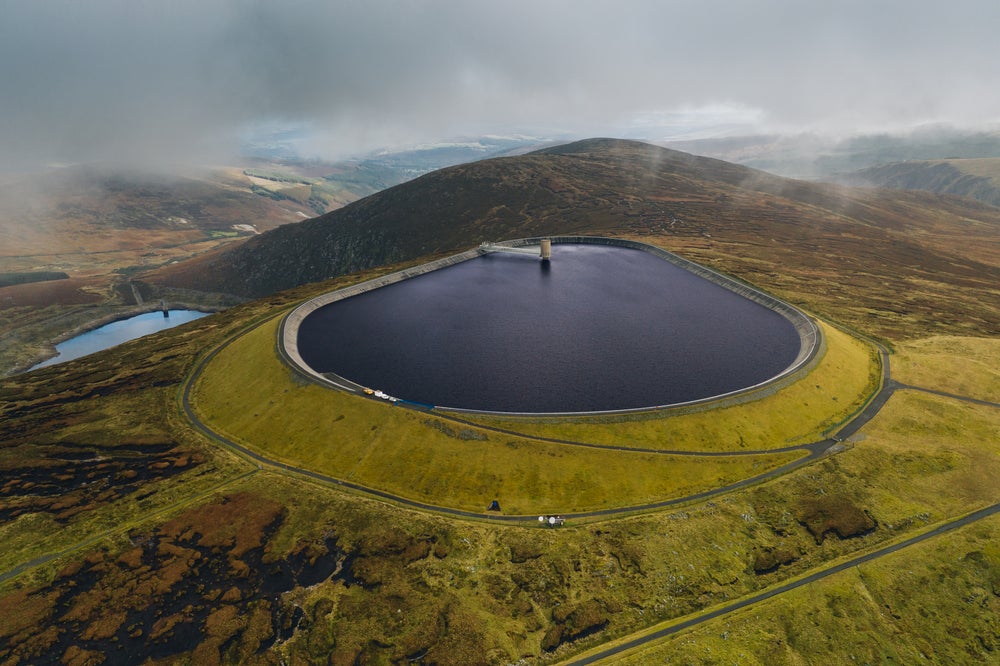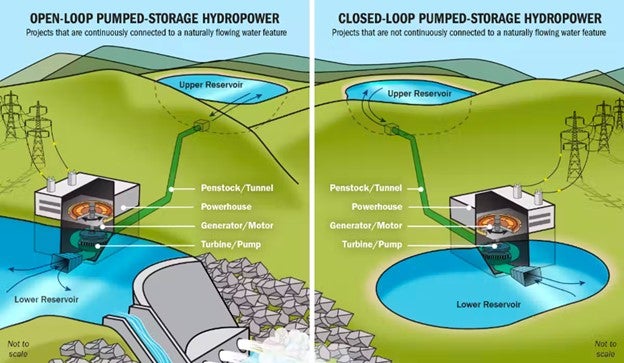The Renaissance of Pumped Hydro a Net-Zero Stalwart
In its bid to make the Winter Olympics “green and clean”, China turned on the world’s largest pumped hydro storage plant. The $3bn (18.96bn yuan), 3.6GW Fengning Pumped Storage Power Station in Hebei Province will provide 600MW of electricity to the host cities Beijing and Zhangjiakou – avoiding the equivalent of burning 480,000 tonnes of coal a year and reducing CO2 emissions by 1.2 million tonnes.
The Chinese State Grid Corporation opened another five pumped hydro stations last year and plans to increase its pumped storage capacity from the current 26.3GW to 100GW by 2030. All over the world, grid operators are desperately searching for long-duration energy storage solutions to leverage renewable energy as baseload power and address the variable nature of clean resources.

Discover B2B Marketing That Performs
Combine business intelligence and editorial excellence to reach engaged professionals across 36 leading media platforms.
“[Pumped hydro] will play a significant role in supporting the deployment of variable energy sources, as other storage solutions alone cannot provide adequate storage and sufficient grid flexibility,” says François Le Scornet, a senior consultant at Carbonexit Consulting. “The demand for pumped storage can be expected to grow quite significantly over the coming decades.”

When the sun doesn’t shine and the wind doesn’t blow
Pumped hydro energy storage (PHES) has been in use for more than a century. It involves pumping water from a lower to an upper reservoir when there is spare power generation capacity (on windy or sunny days, for example), and letting it run down to the lower reservoir via a turbine to generate electricity when there is a shortfall – such as at night.
Power grids need to be able to match incoming electricity supply to demand in real time, or they experience shortages or overloads. There are various ways grid operators can do this, including sharing power across large regions via transmission lines and locally via distribution grids, controlling demand (such as providing financial incentives for people to charge their electric vehicles in non-peak hours), and storing energy. For the latter, batteries and PHES have become the options of choice.
“Together, batteries and PHES can completely replace the ancillary services [that help grid operators maintain a reliable electricity system] hitherto provided by fossil and nuclear generators,” says Andrew Blakers, professor of engineering at the Australian National University.

US Tariffs are shifting - will you react or anticipate?
Don’t let policy changes catch you off guard. Stay proactive with real-time data and expert analysis.
By GlobalDataAs the world looks to wean itself off fossil fuels, around two-thirds of the electricity generation capacity added each year is now coming from wind and solar. However, due to their innate variability, these renewables require energy storage. For grids with small amounts of wind and solar, traditional coal, gas and hydro generators can effectively balance supply and demand, but as those amounts increase – as they now are all over the world – the need for storage capacity grows.
PHES currently makes up 94% of installed global energy storage capacity. According to the International Hydropower Association, PHES plants today can store around 9,000 gigawatt-hours (GWh) of power. Countries such as Japan have installed huge quantities of PHES capacity, allowing its nuclear and fossil fuel fleet to maintain nearly constant output.
Batteries make up most of the remainder of the electricity storage market. They are rapidly falling in price and can compete with PHES for short-term storage (minutes to hours), but PHES is much cheaper for long-duration energy storage (overnight or multiple days) and has a longer lifespan, at 50–100 years.
“Pumped hydro is by far the cheapest overnight storage," says Blakers. "Importantly, the working fluid is water rather than battery chemicals.”
Most PHES plants were built from the 1960s to the 1980s, and by 2005 there were more than 200 in operation globally – often developed in conjunction with traditional river-based hydroelectric dams. They fell out of fashion due to concerns over their environmental impact, but have experienced something of a renaissance as countries search for storage solutions for their rapidly expanding renewables portfolios.
The world’s leading PHES projects
There are numerous large PHES projects in development around the world today. In Uzbekistan, state-owned hydropower producer and project developer JSC Uzbekhydroenergo is in discussions with French state-owned utility EDF over the construction of a 200MW PHES project in the Tashkent region.
In the UAE, the Dubai Electricity and Water Authority is building a 250MW plant in the Hajar Mountains. It will be the first PHES plant in the Arabian Gulf and is expected to come online in early 2024.
In the US, Eagle Crest Energy is developing a 1,300MW plant with 18 hours of storage at a former iron mine in California. The project is scheduled to come into service in 2027, but currently hangs in the balance after local groups raised concerns over its potential impact on the local environment and groundwater.
In Scotland, developer ILI Group announced in June 2021 that proposals for the £550m ($774m), 450MW Red John PHES plant on the shores of Loch Ness had been approved by the government.
Australia’s first PHES plant in nearly 40 years is set to be completed by 2024. The 250MW Kidston Stage 2 facility in Queensland will cost approximately $600m. There are also two other large-scale PHES projects in development in New South Wales; the 2GW Snowy 2.0 project and the 600MW Oven Mountain project.
Greenko Group’s Pinnapuram Pumped Storage Project in Andra Pradesh, India, is expected to be commissioned in 2023. It will combine 2GW of solar PV with 400MW of wind and 1.2GW of PHES, and, having been awarded a tariff of $0.054 per kilowatt-hour, is considered the lowest-cost solar-plus-storage project proposal in the world.
No silver bullet
Nonetheless, not everyone is sold on the idea – and PHES has a number of drawbacks that impede its silver-bullet storage status. According to a recent literature review, the main barriers to PHES are a lack of supporting infrastructure such as roads and transmission lines; limited favourable topographies; high capital, operation and maintenance costs; and long payback periods.
“Today’s hydropower capacity means [PHES] can only play a minor role,” says Arij Van Berkel, vice-president and group director of energy research at Lux Research, a US-based research and advisory company. “Expanding that capacity is incredibly disruptive to the environment compared with other energy storage options. In addition, there are many other limiting factors such as the use of water in agriculture.”
Van Berkel believes existing PHES can play a modest but significant role in the energy transition by providing long-duration storage for about 8% of global electricity production. Expanding it will be tough, he says.
[Keep up with Energy Monitor: Subscribe to our weekly newsletter]
Hydropower often requires flooding, and constructing extensive connecting infrastructure with knock-on impacts for the local environment and communities. A recent study found that 631 hydropower dams built since 2001 were associated with reduced local economic growth, population and greenness in areas within 50km of the dam sites, particularly in the Global South.
Global warming itself reduces the potential of PHES through increased evaporation from the reservoirs and bigger fluctuations in their levels. During Norway’s extremely dry summer of 2019, reservoirs fell below critical levels, jeopardising the security of the country’s electricity supply.
The nature of hydropower also means projects are large and take a long time to develop and build. “As the energy transition accelerates, other storage options that are easier to scale in small and fast steps will be more convenient,” says Van Berkel.
'Off-river' solutions
Dams are rightly controversial, and most of the existing PHES systems are indeed river-based – but they don’t have to be. “Pumped hydro storage is often overlooked because of concern about hydropower’s impact on rivers, but what many people don’t realise is that most of the best hydro storage sites aren’t on rivers at all,” says Australian National University's Blakers.
Creating 'closed-loop' or 'off-river' PHES systems that use pairs of existing lakes or reservoirs instead of rivers would bypass the need for new dams, with little additional land demand except for transmission lines. A pair of 250-acre, 20m-deep reservoirs with an altitude difference of 600m can store 24GWh of energy, meaning the system could supply 1GW of power for 24 hours, enough for a city of a million people.
In addition, evaporation suppressors – small objects floating on the water to trap humid air – can help reduce water evaporation. On average, the water required for an off-river PHES system equates to about three litres per person per day, equivalent to 20 seconds of a morning shower or one-tenth of the water evaporated per person per day in the cooling systems of US fossil fuel power stations.
The energy stored in an off-river PHES system is usually less than in a river-based hydroelectric dam, but much more than a utility-scale battery. Construction of off-river PHES systems can also be much faster than other storage methods: timetables of 2–3 years are feasible for 10GWh storages. Although an individual battery can be completed in a few months, it is typically two orders of magnitude smaller than an off-river PHES system.
Off-river PHES also boasts a much greater number of potential sites than its on-river counterpart. In a global survey of greenfield off-river PHES undertaken in 2019, the Australian National University found 616,000 appropriate sites around the world. Each site comprised a closely spaced reservoir pair with a defined energy storage potential of 2, 5, 15, 50 or 150GWh.
“The world has 100 times more off-river pumped hydro storage potential than needed to support a 100% renewable energy system based on solar and wind,” says Blakers.

For those areas without the geography for off-river pumped hydro, there are solutions. In case there is no water, a company called Energy Cache has adapted the PHES system to use gravel instead. A system of buckets on a line picks up gravel at the bottom of a hill and moves it to the top; when the process is reversed, the gravel moves back down the hill and powers a generator to produce energy. If there is no hill, a company called Quidnet Energy – backed by Bill Gates’s Breakthrough Energy Ventures – is pioneering a system that uses renewable energy to pump water into underground wells, creating huge amounts of pressure. When that energy is needed, the pressure is released, pushing the water up the well and through a turbine, generating electricity.
Pumped hydro’s role in net zero
Decarbonisation requires electrification. According to Blakers et al, electricity demand will triple as transport, heating and industrial manufacturing go electric. Some of these energy consumers have built-in storage capacity: batteries in electric vehicles, hot water in storage tanks, and hydrogen and carbon in chemical synthesis plants. However, the storage requirements of wind and solar-powered grids are likely to require a combination of PHES, utility-scale batteries and demand management on top.
According to Blakers, per capita electricity consumption in advanced economies is around 5–10MWh per person annually. Eliminating fossil fuels from the economy entails tripling electricity production, which would see it rise to 20MWh per person annually. The global population is expected to peak at ten billion mid-century, pushing global electricity production requirements to approximately 200,000TWh annually.
Most countries aim to meet this increasing demand by massively scaling up wind and solar resources. Assuming, by 2050, electricity is being produced by a combination of solar (60%), wind (30%) and other methods (10%), Blakers forecasts a need for 81TW of solar and 17TW of wind power. In that scenario, one day of storage would amount to about 500TWh and require 20TW. That is vastly more than the 9,000GWh PHES plants can store today, but much smaller than the 23,000TWh of potential off-river PHES capacity Blakers believes exists around the world.





